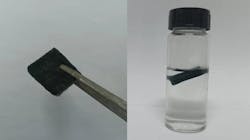A floating sponge could help remove harmful algal blooms
A new study in ACS ES&T Water tests a floating sponge coated in a charcoal-like powder that, when paired with an oxidizing agent, destroyed 85% of algal cells from lake and river water samples, according to a press release by the American Chemical Society.
Swaths of electric green and bright orange-red harmful algal blooms (HABs), or the less brilliantly colored cyanobacteria Microcystis aeruginosa, can produce toxins that can sicken humans and animals. Researchers have shown that acids and strong oxidizing agents damage and destroy M. aeruginosa cells but simultaneously generate unwanted, potentially harmful products.
More recently, Jiangfang Yu, Lin Tang and colleagues suggested that persulfate-based oxidants could control this species’ algal blooms, but these compounds require catalysts, such as powdered biochar — a charcoal-like substance made from carbon-containing waste — to be effective. So, the team wanted to develop a floating material containing biochar that would boost the destruction of harmful algal cells without damaging the environment with by-products.
The researchers started with a porous sponge made of melamine and developed a powdered biochar from shrimp shells. They sandwiched a thin layer of polyvinyl alcohol between the sponge and the biochar, linking the layers together at 572 degrees Fahrenheit.
In combination with a persulfate-based oxidizing agent, the floating sponge damaged the membranes of about 90% of the M. aeruginosa cells in lab dishes within five hours. After the membranes split apart, the cells released their internal contents, which rapidly broke down into smaller components.
In addition, the researchers applied the catalyst sponge and persulfate system to real-world lake and water samples, and found that it inactivated more than 85% of the algal cells. Based on the results, the team suggests that the new system could be a successful algal remediation technique in environments affected by blooms.


